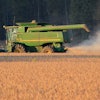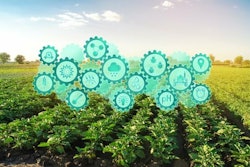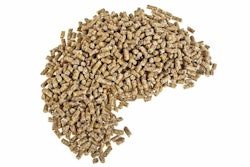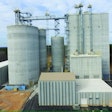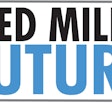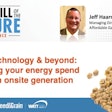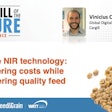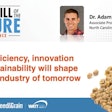WEM Automation CEO Pete Ensch discusses the ways the Internet of Things (IoT) and data will improve feed production, efficiencies in the future
Sensor technology has become an integral part of modern feed production, enhancing productivity and profitability at a lower cost than ever before.
WEM Automation‘s CEO Pete Ensch joined the Chat to examine the ways sensors contribute to feed mill internet of things (IoT) and traceability.
成绩单:饲料战略由皮特Ensc聊天h, CEO, WEM Automation
Jackie Roembke, editor in chief, WATT Feed brands/Feed Strategy:Hello everyone and welcome to Feed Strategy Chat. I am your host, Jackie Roembke, editor in chief of WATT Feed brands and Feed Strategy magazine.
This edition of Feed Strategy Chat is brought to you by WATT Global Media and FeedStrategy.com. FeedStrategy.com is your source for the latest news and leading-edge analysis of the global animal feed industry.
Today we are joined on Zoom by Pete Ensch, CEO of WEM Automation. He is here to discuss industry 4.0, and how it will shape the future of the production. Hi Pete, how are you?
Pete Ensch, CEO, WEM Automation:I’m doing well, Jackie. Thanks for having me.
Roembke:Great, thank you so much for being here. Well, let’s get right into it. Do me a favor anddefine Industry 4.0 for our audience, and also examine how it applies to feed production.
Ensch:I think Industry 4.0 is one of those buzz terms that it’s being used quite a bit, but I’m not sure people really do understand what it is. But essentially, it’s really the the concept of breaking down your plant floor to the lowest level and creating an intranet within your smart factory and applying sensors to all of the equipment. Then gathering data with some of the advancements we’ve seen with industrial networks and pulling all that information into a central location where you can use computers to do the analysis on the fly and automate a lot of your decision making.
So your systems can take care of themselves.
Roembke: Please identify those key areas of production that could really benefit from access to real-time data, and what are some of those returns?
Ensch:Sure, I mean, I think the two greatest opportunities are probably within batching and pelleting — and those are the probably the two more complicated processes that are out there. And they are processes that can be monitored with sensors to understand different physical conditions, things like temperature, moisture, vibrations, and use those inputs on the physical conditions to actually use it as inputs to feedback loops that can control the equipment and make adjustments on the fly.
Roembke: Do you typically see your customers asking for these types of insights? Or is this something that is still a developing area of technology and may not be front and center?
Ensch:我认为这是有点的。我认为我们看到的some customers who are definitely thinking along these terms, and are coming to us looking for a partner or a solution. But there’s a lot of people in the feed industry that this is new to them. And it’s some technology that’s a little, you know, a move forward of what they’re thinking.
Roembke: What kinds of investments in equipment, other capital investments, are required to thoroughly and properly get these sensors in place and have the systems to support them?
Ensch:Yeah, it’s come down quite a bit. So I think that’s one of the real changes in the past, call it 10 to 15 years, the cost of a lot of sensors has really come down. Sensors that used to be over $1,000 are now in a couple $100 range. So it really is amazing how much less it costs to implement it in your plant.
And if you look at just the all of the industrial networking that has to be done to bring everything together, that’s come down in price as well. Cost of computers is down, cost of storage is down.
It’s really kind of a fraction of the cost that it used to be to instrument your plant.
Roembke: Great. Where do you see these advances in smart factory technology taking the feed industry in the future?
Ensch:I think a lot of it is around just better control, which leads to improved quality. So I think that’s one of the things, it’s bringing just greater consistency.
I think it’s also really helping with improvements around preventative maintenance, because you can use a lot of these signals to trigger preventative maintenance, so that you can take care of it offline and not worry about unscheduled downtime, which helps you with your delivery and with maintaining your cost.
And I think probably the third biggest area is just on the traceability side. It just allows us to track more data and break it down into every batch and every loadout. So you have the ability to not only look at the data live, you have the ability to go back with time, and trend data and understand how you can use that data to improve your processes over time.
Roembke: And are there any key areas or points that maybe we haven’t discussed so far, that you’d like to touch on?
Ensch:I think the great thing about it is you can apply it across your entire plant.
So you really can do it everywhere from receiving the loadout and even use it for tracking outside of your facility. You can track it all the way down to the the end user or farm if you want. So I think the traceability you can extend out as much as you as you want. But, you know, the good thing is you don’t have to do it all. You can start in one area and kind of, you know, figure out what works for you and then kind of expand from there.
Roembke:Very good. Thank you so much. And if you would like more information about how new technologies may impact the production in the future, please make sure to subscribe to the “Feed Mill of the Future” digital supplement.
Thank you so much, Pete, and thanks to you for tuning in.
Ensch:Thank you, Jackie.
Announcing the Feed Mill of the Future digital supplement
WATT’s feed brand’s Feed Strategy and Feed & Grain magazines join forces to launch the monthly Feed Mill of the Future digital supplement. Each edition aims to provide animal feed industry stakeholders with forward-looking content, market insights and a spotlight on the leading-edge technologies shaping the global feed industry of tomorrow.
Subscribe today!https://bit.ly/3dWzow7

